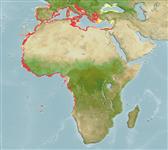Environment: milieu / climate zone / depth range / distribution range
Ecologie
marien demersaal; diepte 15 - 200 m (Ref. 5222), usually 15 - 50 m (Ref. 2683). Subtropical; 43°N - 16°S, 20°W - 38°E (Ref. 5222)
Eastern Atlantic: Portugal to southern Angola; reports from islands require confirmation. Specimens from Madeira, Azores, Canary Islands, and Cape Verde have been examined by Heemstra (1991, Ref. 6512) and are identified to be Mycteroperca fusca. Replaced by Mycteroperca acutirostris in the western Atlantic.
Lengte bij maturiteit / Grootte / Gewicht / Leeftijd
Maturity: Lm 34.0, range 32 - 36 cm
Max length : 144 cm TL mannelijk / geslacht onbekend; (Ref. 40637); common length : 80.0 cm TL mannelijk / geslacht onbekend; (Ref. 2683); max. gepubliceerd gewicht: 49.7 kg (Ref. 40637)
Korte beschrijving
Determinatiesleutels | Morfologie | Morfometrie
Dorsale stekels (totaal) : 11; Dorsale zachte stralen (totaal) : 15 - 17; Anale stekels: 3; Anale zachte stralen: 11 - 12. Distinguished by the following characteristics: usually reddish brown, sometimes mottled with black or pale grey spots with black streak above maxilla; juveniles with black saddle blotch on peduncle; oblong body, compressed, depth contained 2.8-3.2 times in SL; head length 2.5-2.7 in SL; convex interorbital area; enlarged serrae at angle of preopercle, forming rounded lobe set off by the indentation immediately above; nostrils subequal in juveniles, posterior nostrils about twice that of anterior ones in adults (Ref. 89707).
Occurs over rocky and sandy bottoms; young individuals very common in mangrove-lined lagoons. Feeds on mollusks (presumably cephalopods) and small fishes (Ref. 89707). Marketed fresh.
Levenscyclus en paargedrag
Maturiteit | Voortplanting | Paaien | Eieren | Fecunditeit | Larven
Heemstra, P.C. and J.E. Randall, 1993. FAO Species Catalogue. Vol. 16. Groupers of the world (family Serranidae, subfamily Epinephelinae). An annotated and illustrated catalogue of the grouper, rockcod, hind, coral grouper and lyretail species known to date. Rome: FAO. FAO Fish. Synop. 125(16):382 p. (Ref. 5222)
Status op de Rode Lijst van het IUCN (Ref. 130435: Version 2024-1)
Gevaar voor de mens
Harmless
Gebruik door de mens
Visserij: van minder commercieel belang
Tools
Speciale rapporten
Download XML
Internetbronnen
Estimates based on models
Preferred temperature (Ref.
123201): 15.3 - 27.4, mean 19.4 °C (based on 296 cells).
Fylogenetische diversiteitsindex (Ref.
82804): PD
50 = 0.5000 [Uniqueness, from 0.5 = low to 2.0 = high].
Bayesian length-weight: a=0.01072 (0.00685 - 0.01675), b=3.01 (2.88 - 3.14), in cm total length, based on LWR estimates for this species & Genus-body shape (Ref.
93245).
Trofisch niveau (Ref.
69278): 4.1 ±0.58 se; based on food items.
Generation time: 10.4 ( na - na) years. Estimated as median ln(3)/K based on 1
growth studies.
Weerstandsvermogen (Ref.
120179): Zeer laag, minimale populatieverdubbelingstijd meer dan 14 jaar (Preliminary K or Fecundity.).
Fishing Vulnerability (Ref.
59153): High to very high vulnerability (67 of 100).
Nutrients (Ref.
124155): Calcium = 34.6 [15.2, 67.1] mg/100g; Iron = 0.82 [0.44, 1.54] mg/100g; Protein = 18.6 [16.6, 20.2] %; Omega3 = 0.331 [0.208, 0.544] g/100g; Selenium = 40.9 [19.7, 83.1] μg/100g; VitaminA = 13.4 [4.2, 49.3] μg/100g; Zinc = 0.474 [0.334, 0.700] mg/100g (wet weight);
